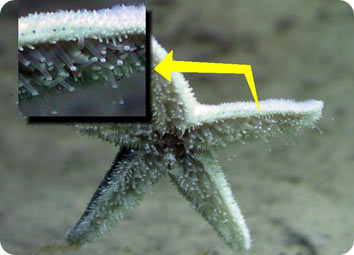When a starfish moves along the bottom of the ocean, it almost looks like it’s gliding. It’s not, though -- it’s walking on hundreds of tiny “legs” that are powered by seawater.
 Starfish with an enlargement showing tube feet. Credit: Wikipedia/Fritz Geller-Grimm
Starfish with an enlargement showing tube feet. Credit: Wikipedia/Fritz Geller-Grimm The starfish -- more correctly known as a sea star -- is propelled by a network of water-filled tubes and sacs known as the water vascular system. Water enters the sea star through an opening located between two of the creature’s five “arms.” A sieve-like structure inside this opening filters out solid particles.
The filtered water flows through a small canal into a wider ring-shaped canal in the middle of the sea star. Five canals branch off from this ring, extending to the tip of each arm.
Hundreds of tiny “sacs” are connected to the canals. They serve as reservoirs for the seawater, like the brake fluid container in your car. Tiny “tube feet” extend from the bottom of each sac. They’re arrayed in rows along the bottom of each arm.
When the sea star wants to move, it contracts muscles around the appropriate sacs, forcing water into the tube feet. Tiny suckers on the ends of the feet latch on to the solid ground below them. The suckers can also attach to the shells of clams or other prey, giving the sea star a firm grip that helps it work the shell open.
Muscles in the tube feet then move to propel the sea star in the proper direction.
This system isn’t exactly rapid transit -- a sea star typically moves only a few inches per minute. But it propels the creature in a seemingly effortless glide across the bottom of the sea.

